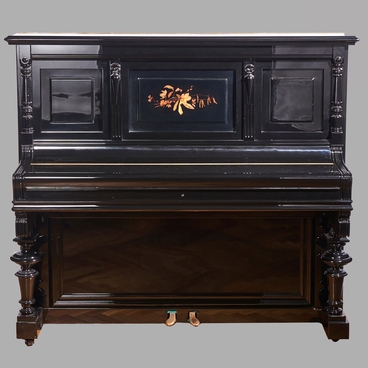The tiles of the masonry heater, presented in the interior of the museum, came from the house of the merchant Grammatikopoulos, who was engaged in the wholesale trade of tobacco and bread.
The mansion was built around 1910 and was located in the historical center of Novorossiysk, on Tsemesskaya Street (since 1925 it has been called Street named after A.Yu. Gubernsky). The stove was used from a room adjacent to the wall (a hall or a special closet) and not only warmed, dried and purified the air in the room or front hall, but also served as its interior decoration.
Stove tiles are not simple ceramic tiles: on the reverse side, they look like an open box. Holes were made in the upper and lower parts of the tile, into which nails were inserted vertically. The space was previously stuffed with clay and crushed stone. Tiles were fastened with iron wire, which was fired, twisted two times, attached to nails and bar iron at the corners inside the heater that was installed vertically.
The tiled stove warmed up quickly and remained heated for a long time. This was achieved thanks to a layer of air between the tiles and the wall of the stove — it heated up and retained heat.
The glaze lay in a dense glassy layer on a porous shard, protecting the surface of the tile from soot, and the room from smoke. The stove body from Grammatikopoulo’s house is tiled with smooth white glazed tiles and enclosed in a richly decorated relief frame with an “oriental cucumber” ornament. The crowning part — the pommel — has a complex shape, in the form of a kind of massive “crown”.
The protruding false “fireplace” shelf divides the front part into two, and the lower one imitates a fireplace. Another element of stove decor — a painted tile-panel in a rocaille frame — is attached to the front main part of the stove. It is an image of a highlander in an elegant red Circassian coat against a background of a mountain landscape. Such panel tiles were produced at the tile-majolica factory of Bronislav Yakovlevich Lisovsky in Vitebsk and were its main product. The place of production is confirmed by the maker’s marks of the B.Ya. Lisovsky Factory.
The mansion was built around 1910 and was located in the historical center of Novorossiysk, on Tsemesskaya Street (since 1925 it has been called Street named after A.Yu. Gubernsky). The stove was used from a room adjacent to the wall (a hall or a special closet) and not only warmed, dried and purified the air in the room or front hall, but also served as its interior decoration.
Stove tiles are not simple ceramic tiles: on the reverse side, they look like an open box. Holes were made in the upper and lower parts of the tile, into which nails were inserted vertically. The space was previously stuffed with clay and crushed stone. Tiles were fastened with iron wire, which was fired, twisted two times, attached to nails and bar iron at the corners inside the heater that was installed vertically.
The tiled stove warmed up quickly and remained heated for a long time. This was achieved thanks to a layer of air between the tiles and the wall of the stove — it heated up and retained heat.
The glaze lay in a dense glassy layer on a porous shard, protecting the surface of the tile from soot, and the room from smoke. The stove body from Grammatikopoulo’s house is tiled with smooth white glazed tiles and enclosed in a richly decorated relief frame with an “oriental cucumber” ornament. The crowning part — the pommel — has a complex shape, in the form of a kind of massive “crown”.
The protruding false “fireplace” shelf divides the front part into two, and the lower one imitates a fireplace. Another element of stove decor — a painted tile-panel in a rocaille frame — is attached to the front main part of the stove. It is an image of a highlander in an elegant red Circassian coat against a background of a mountain landscape. Such panel tiles were produced at the tile-majolica factory of Bronislav Yakovlevich Lisovsky in Vitebsk and were its main product. The place of production is confirmed by the maker’s marks of the B.Ya. Lisovsky Factory.


